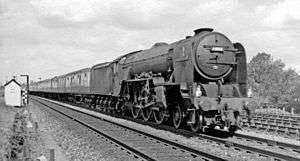LNER Thompson Class A1/1
The LNER Class A1/1 consisted of a single 4-6-2 "Pacific" express passenger locomotive rebuilt in 1945 from an A1 class locomotive, by Edward Thompson. It was intended as the prototype of a new design of pacific locomotives improving the A4 design of Thompson’s predecessor Sir Nigel Gresley. No further examples were built due to Thompson’s retirement in 1946.
- Disambiguation: LNER Class A1 LNER Class A1/A3, LNER Peppercorn Class A1
| LNER Thompson Class A1/1 | |||||||||||||||||||||||||||||||||||
|---|---|---|---|---|---|---|---|---|---|---|---|---|---|---|---|---|---|---|---|---|---|---|---|---|---|---|---|---|---|---|---|---|---|---|---|
 The single Thompson A1/1 Pacific 60113 Great Northern near Peterborough in 1959 | |||||||||||||||||||||||||||||||||||
| |||||||||||||||||||||||||||||||||||
| |||||||||||||||||||||||||||||||||||
| |||||||||||||||||||||||||||||||||||
| |||||||||||||||||||||||||||||||||||
Background
When Edward Thompson was appointed Chief Mechanical Engineer of the London and North Eastern Railway in April 1941, he envisaged a new standardisation programme involving ten locomotive designs including two Pacific types.[1] These were an express passenger type (designated A1) with 6 ft 8 in (2.032 m) driving wheels and a ‘heavy passenger and freight’ type (designated A2) with 6 ft 2 in (1.880 m) driving wheels. He was not able to proceed with his plan due to the Second World War but did try out some of his ideas by rebuilding Nigel Gresley’s P2 class 2-8-2 as A2/2 pacifics and building the last four V2 class already on order as A2/1 pacifics. At last in July 1944 Thompson began work on designing his new A1 class which would be an improved version of the A4 class. However before building any new locomotives he decided to rebuild one of the surviving Gresley pacifics of the A1 class to try out the new design.[2]
Design
Thompson drew up two modified 3-cylinder designs both of which discarded the Gresley conjugated valve gear and had separate sets of Walschaerts valve gear for each cylinder. Due to space restrictions, the middle cylinder could not be parallel with the outside cylinders. One design had the middle cylinder forward of the outside cylinders, whilst the chosen design had the middle cylinder further back. Both designs used A4 boilers.[3] A new set of frames was built for the rebuild. These were similar to A4 frames except for the wheel spacings at the front. Thus very little of the original locomotive was retained. The resulting wheelbase was 38 ft 5 in (11.709 m), even longer than the Gresley P2s.
Rebuilding
No. 4470 Great Northern (the very first Gresley Pacific) was chosen for this rebuilding, rather than being retained for future preservation. There has been much debate on the reason for this choice. Some state it as bad luck, whilst others clearly blame Thompson for letting his personal feelings towards Gresley cloud his judgement. O. S. Nock describes it as ‘the most disappointing and tactless act in his short and stormy career as CME,’[1] and Allen stated ‘he turned it into a machine of such hideous appearance as might well have made its designer turn in his grave.’[4] It is known that the Chief Draughtsman and a number of high up officials within the LNER unsuccessfully tried to deter Thompson from rebuilding this particular engine. The rebuilt locomotive appeared in traffic in September 1945 and was classified A1 and the remaining sixteen locomotives of Gresley’s A1 class were re-classified A10. Originally, the plan was to rebuild all of these to the new design but this never occurred. There were also plans for streamlining all the members of the new A1 class, but these were never acted upon.[2]
New-build Class A1
In October 1945, the order was given to construct sixteen new locomotives to the new A1 plan. However, before these could be built Thompson had retired and Arthur Peppercorn had taken over as CME and he deferred building them until 1948, by which time he had altered the design to become the Peppercorn Class A1 Pacific design. In 1947 Great Northern, up to then the sole member of the class officially designated Class A1, was reclassified Class A1/1 in anticipation of these new Peppercorn A1s.
The A1/1 in service
In the first few years of service, the rebuilt Great Northern suffered a number of teething problems. These were fixed, but it never played a prominent role on the East Coast Main Line. Although it was occasionally allocated to Kings Cross, it spent much of its career based at Doncaster or Grantham. Great Northern was even allocated to be the Grantham pilot for a while during the mid-1950s.
Renumbering
Great Northern was renumbered No. 113 in Thompson's 1946 renumbering scheme. It then became No. 60113 during British Railways ownership.
Withdrawal
60113 was withdrawn on 19 November 1962 with a badly worn cylinder and was then broken up at Doncaster Works. An attempt to save the engine from the cutter's torch was unsuccessful.
Models
PDK Models produce a kit of the A1/1 for 4 mm scale / OO gauge.
References
- Nock 1984, p. 115.
- Boddy, Neve & Yeadon 1973, p. 174.
- Boddy, Neve & Yeadon 1973, pp. 174 and 212.
- Allen 1962, p. 99.
- Allen, Cecil J. (1962). British Pacific Locomotives. London: Ian Allan.CS1 maint: ref=harv (link)
- Nock, O.S. (1984). British Locomotives of the Twentieth Century Vol. 2 1930-1960. London: Book Club Associates.CS1 maint: ref=harv (link)
- Boddy, M. G.; Neve, E.; Yeadon, W. B. (April 1973). Fry, E. V. (ed.). Locomotives of the L.N.E.R., Part 2A: Tender Engines—Classes A1 to A10. Kenilworth: RCTS. ISBN 0-901115-25-8. 231pp.
- Yeadon, Willie (1991). Yeadon's Register of LNER Locomotives, Vol. 3: Raven, Thompson and Peppercorn Pacifics.
External links
- The Thompson A1/1 Pacific LNER Encyclopedia